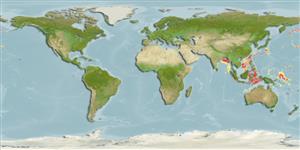>
Ophidiiformes (Cusk eels) >
Ophidiidae (Cusk-eels) > Neobythitinae
Etymology: Enchelybrotula: Greek, enchelys, -yos = eel + Latin, brotula, -ae = little, bud, shoot (Ref. 45335).
More on authors: Smith & Radcliffe.
Environment: milieu / climate zone / depth range / distribution range
Ecología
marino batidemersal; rango de profundidad 1993 - 2820 m (Ref. 27746). Deep-water
Indo-Pacific: known from two specimens taken from the Celebes Sea and Bay of Bengal.
Tamaño / Peso / Age
Maturity: Lm ? range ? - ? cm
Max length : 54.7 cm TL macho / no sexado; (Ref. 41039)
Radios blandos dorsales (total) : 130. Body long and compressed; head short, 3 or more times in preanal; eyes small; branchiostegal rays 7; jaw teeth sharp-pointed, compressed, in a single row; median basibranchial tooth patches 2; gill rakers short, spiny tubercle pads; caudal fin rays 8; precaudal vertebrae 22-23 (Ref. 34024). Body depth at anus greater than head length (Ref. 34024).
Rare species (Ref. 34024). Oviparous, with oval pelagic eggs floating in a gelatinous mass (Ref. 205).
Life cycle and mating behavior
Maturities | Reproducción | Spawnings | Egg(s) | Fecundities | Larva
Nielsen, J.G., D.M. Cohen, D.F. Markle and C.R. Robins, 1999. Ophidiiform fishes of the world (Order Ophidiiformes). An annotated and illustrated catalogue of pearlfishes, cusk-eels, brotulas and other ophidiiform fishes known to date. FAO Fish. Synop. 125(18):178p. Rome: FAO. (Ref. 34024)
IUCN Red List Status (Ref. 130435)
Threat to humans
Harmless
Human uses
Pesquerías: sin interés
Herramientas
Special reports
Download XML
Fuentes de Internet
Estimates based on models
Preferred temperature (Ref.
123201): 1.8 - 3.6, mean 2.3 °C (based on 160 cells).
Phylogenetic diversity index (Ref.
82804): PD
50 = 0.7500 [Uniqueness, from 0.5 = low to 2.0 = high].
Bayesian length-weight: a=0.00380 (0.00165 - 0.00876), b=3.14 (2.93 - 3.35), in cm total length, based on LWR estimates for this (Sub)family-body shape (Ref.
93245).
Nivel trófico (Ref.
69278): 3.7 ±0.6 se; based on size and trophs of closest relatives
Resiliencia (Ref.
120179): Medio, población duplicada en un tiempo mínimo de 1.4-4.4 años (Preliminary K or Fecundity.).
Fishing Vulnerability (Ref.
59153): Moderate vulnerability (42 of 100).
